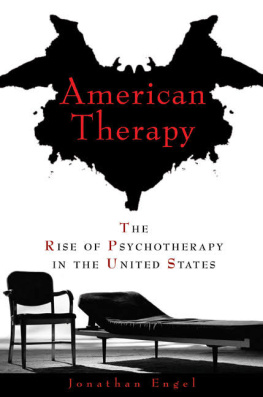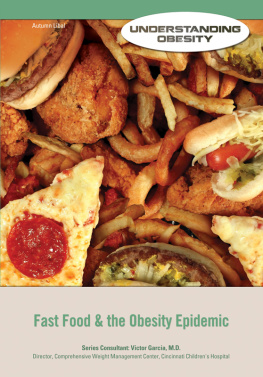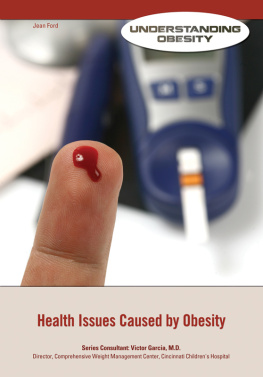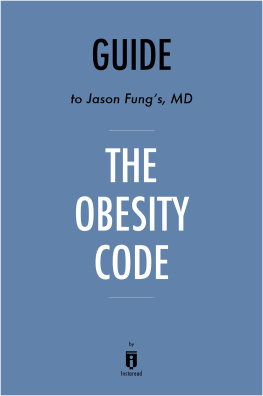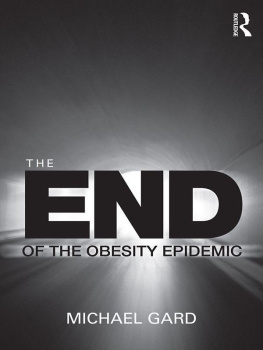About the Author
Jonathan Engel writes about the historical evolution of US health and social welfare policy. His books are Doctors and Reformers: Discussion and Debate over Health Policy, 19251950 (2002); Poor Peoples Medicine: Medicaid and American Charity Care since 1965 (2006); The Epidemic: A Global History of AIDS (2006); American Therapy: The Rise of Psychotherapy in the United States (2008); and Unaffordable: American Healthcare from Johnson to Trump (2018). Engel is a professor at the Marxe School of Public and International Affairs, CUNY. In addition, he has taught at the Mailman School of Public Health at Columbia University and the School of Public Health at the University of Massachusetts.
1 An Old Problem
I n 1952, the director of the National Institutes of Health (NIH), W. H. Sebrell Jr., announced that obesity was the number one nutritional problem in the United States, superseding malnutrition and vitamin deficiency.
The cause of the problem was disarmingly simple. In 1947, Hilde Bruch of Columbia Universitys Department of Psychiatry announced to the world that obesity was caused by overeating. (Time magazine deemed the insight headline catching.
The problem had hardly started in 1952. As early as 1947 the United States Public Health Service (PHS) went hunting for undiagnosed diabetes in Oxford, Massachusetts (the birthplace of Clara Barton, founder of the Red Cross) and discovered, as suspected, that diabetes was sharply on the rise. Extrapolating from the Oxford findings, the PHS raised its estimate of diabetes cases in the nation from 1.5 million to 2.8 million.
The 1980s were a watershed decade for American obesity. Numbers had been rising gradually for decades, but from 1980 to 1995, the increase accelerated sharply. In that time, the portion of Americans who were seriously overweight jumped from a quarter of the population to a third. Fifty-eight million Americans weighed more than 20 percent above their ideal body weight, and the average American adult was eight pounds heavier than he or she had been at the beginning of the era. Indeed, seven years after losing weight, only 2 percent had managed to keep most of it off.
By 1998, 97 million adult Americans were overweight or obese, making it, by most measures, the fattest industrialized country in the world.
Perhaps more worrisome was the rapid rise in childhood obesity. During the same period of increase in adult obesity, childhood obesity rose 54 percent, and adolescent obesity rose 39 percent. The gains in obesity among African American children were even higher. Furthermore, newer data belied the old myth that chubby children thinned out in adolescence and young adulthood. In fact, childhood obesity appeared to be highly correlated with adult obesity, and the earlier the problem started, the more intractable it seemed to be.
Childhood obesity was wrought from the same two causes as adult obesityinactivity and overeatingbut seemed to be particularly compounded by television watching. Data collected in the 1990s repeatedly pointed to television as a particularly noxious culprit in producing chubby kids, even while holding household income and education constant.
Rising obesity in children was bringing the same toxic mix of type II diabetes, high blood pressure, metabolic syndrome, and fatty liver that it did in adults, although cardiac and vascular symptoms tended to hold off until later years. It also brought social isolation, anxiety, and depression. Fat children were more likely to drop out of high school, less likely to finish college, less likely to marry, and less likely to earn high incomes. The risk of dying by middle age was two to three times higher for obese adolescent girls than for their healthy-weight peers. One research team estimated that childhood obesity would shorten life expectancy in the United States by five years within a generation.
Amish children are almost never fat, despite eating diets relatively high in sugar, fat, and carbohydrates. The secret is constant movement: particularly walking. The Amish culture prohibits the use of motorized vehicles. Planetpix/Alamy Stock Photo
The most sobering aspect of the American obesity epidemic has been the rapid increase in the number of overweight and obese children and teenagers. Getty Images
Of greatest concern was the rise in type II diabetes. This insidious disease, previously so unknown in children as to earn the sobriquet adult-onset diabetes, had increased tenfold in adolescents during this period. Unlike type I diabetes in which the pancreas simply produces no insulin, type II diabetes results from the bodys tissues growing insensitive to the catalytic action of insulin. The body produces large amounts of the hormone, but the hormone cannot move glucosethe bodys essential fuelinto muscle cells for metabolism, or into fat cells for storage. Rather, the glucose stays in the blood where it works perniciously over decades to destroy organs and clog capillaries. Long-time sufferers frequently go blind, lose kidney and liver function, and lose limbs to gangrene and amputation.
The costs of the phenomenon were immense. As far back as 1946, physicians recognized the high rates of hypertension, cardiac disease, joint disease, and diabetes associated with fat. Armed with tremendous amounts of demographic and health data from the wartime draft, physicians were able to pinpoint excessive intake of refined starches as a cause of liver disease.
In later decades, scientists refined their conclusions about the ills of obesity and quantified the dangers, but they hardly retracted their conclusions. If anything, obesity seemed to be more dangerous than scientists in the 1950s had supposed. For example, by 1985, oncologists and nutritionists had found that obese women were more likely to die from cancer of the gallbladder, ovaries, breast, and uterus, while obese men were more likely than their slim counterparts to die from cancer of the colon and prostate. In that year, William Castelli, director of the famed Framingham Heart Study, was able to state that over a period of twenty-six years, mortality rates in a studied population rose by 2 percent for each pound an individual was over his or her ideal weight. One observer could only conclude from the research that obesity kills.
By 2004, the costs in lost earnings, medical bills, and suffering due to obesity were stratospheric. Obesity was costing the nation $150 billion annually in medical expenditures, and the cost in lost wages was incalculable. Obesity killed, and its rate of killing could only increase.
As bad as the physical costs of obesity were, however, the psychological and social costs were almost worse. Obese people faced being socially ostracized, ridiculed, and discriminated against. Obese children found themselves marginalized at school and excluded from sports. One overweight teenager remembered how she would sometimes be invited to parties just for laughs and described a mortifying incident in which she was plunked into a trash basket and, unable to get out, was rolled down a hill.
Obese people faced discrimination at all ages and junctures. A series of studies showed that overweight men applying to selective colleges were half as likely to be accepted as their non-overweight counterparts, while overweight women were one-third as likely to be admitted. And both overweight men and women, even when hired, related being regularly passed over for promotions.


